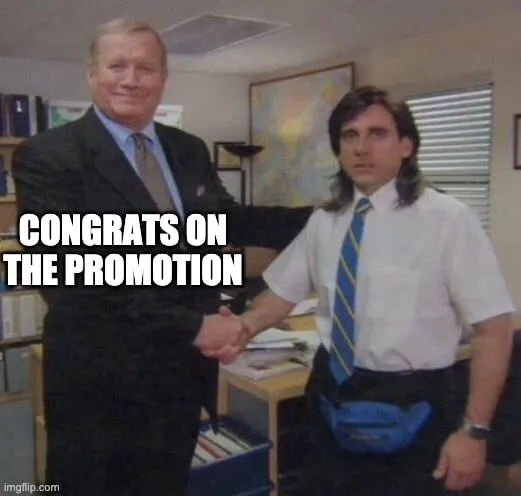
We force humans into linear frameworks. Then we wonder why they burnout.
Ladders Are for Buildings. Humans Need Loops.
Picture this: You’re 28, already leading a team, and someone says, “Next stop: Director!” You nod. Because that’s what grown-ups do, right? Climb the ladder. Play the game. Wait for the title. Wait for permission. Wait for… what, exactly?
Now fast-forward five years. You’re a VP. You’ve got the money, the parking spot, and enough migraines to qualify as a small pharmaceutical trial. You’re bored. Stuck. Disconnected from your craft. And you quietly ask yourself, “Is this it?”
That’s not ambition. That’s autopilot. And it’s time we call it what it is: a socially accepted midlife crisis in slow motion.
The Myth of Linear Growth
People think growth is linear, but growth is messy, cyclical, and often requires U-turns and breakdowns.
Think about it. Nobody tells an artist, “First you draw stick figures, then by year four, you’re Michelangelo.” But in tech, in law, in finance, we cram people into paths so narrow they should come with a safety warning.
David Epstein’s Range makes this painfully clear: generalists who zigzag, explore, and pivot outperform specialists. Why? Because they know how to think, adapt, and learn. That’s real agility. Not title inflation.
“It is no measure of health to be well adjusted to a profoundly sick society.” – Jiddu Krishnamurti
The Manager’s Trap
Camille Fournier’s The Manager’s Path is brilliant, and a little damning. It lays out the classic IC → Tech Lead → EM → Director → VP progression.
Clear. Sensible. Also: a trap if you never question it.
Not everyone wants to manage. And good Lord, not everyone should. Some lead through influence, not headcount. Some scale systems, not org charts. Some grow deep, not tall.
But traditional paths treat that like stagnation. As if mastery isn’t worth as much as meetings.

Better Models: Growth Loops, Jungle Gyms, and Career Arcs
If the old-school ladder is broken, what actually works? You need a model that fits how humans really grow, messy, multi-directional, and shaped by seasons, not salary ranges. Here’s how you build something better:
Growth Loops: Learn, Stretch, Reflect, Repeat
Instead of climbing higher for the sake of a title, think in loops:
- Learn a skill.
- Apply it to a real challenge.
- Reflect on what worked (and what didn’t).
- Build deeper mastery.
Then do it again, but bigger. No new job title required. No performative career theater needed.
This model is about actual capability, not just box-ticking.
It’s how experts are made, through iteration, not ladder rungs.
Jungle Gyms: Grow Sideways, Not Just Up
Sheryl Sandberg first popularized this idea in Lean In, and it’s still one of the best metaphors out there.
Instead of vertical-only promotions, think lateral moves, side quests, cross-functional projects, job shadowing, secondments.
On a jungle gym:
- You can climb sideways.
- You can jump to another part entirely.
- You can even swing backwards for a while to build momentum.
In short: You build range, not just rank.
The modern economy rewards the people who know how to pivot, not just how to stand taller in one spot.
Career Arcs: Seasons, Not Checklists
Here’s a heretical thought: Not every decade of your life needs to be about climbing.
Maybe:
- Your 30s are about learning broadly and taking creative risks.
- Your 40s are about depth, building true mastery.
- Your 50s are about mentoring, legacy, and picking projects that light you up inside.
Your career should feel like a novel, not an assembly line.
There are chapters. Some short. Some sprawling. Some that blow up halfway through and demand a rewrite.
That’s not failure. That’s living.
The Senior Who Said No
I remember her, she was brilliant. Empathetic. Technically lethal. So naturally, the company said: “Time to lead people!”
She said: “I’d rather not.”
They panicked. We didn’t. We built a role around her that fit her strengths, technical strategy, system thinking, mentoring without people management.
Years later? She built the most critical product in the company, and on the way of doing that she mentored many. She didn’t climb. She anchored.
So What Should You Do?
If you’re a leader: burn the ladder. Build something modular, flexible, and human. Give people mobility, not metrics.
If you’re a developer: don’t wait for permission to explore. Track growth by depth and curiosity, not titles and bands.
If you’re in HR: stop designing tracks like pipelines. People aren’t water. Create career maps, not career prisons.
TL;DR: Ladders Are for Firemen. Not for You.
Career ladders are outdated. They’re rigid, joyless, and built for an economy that no longer exists. People grow in spirals, not straight lines. The future belongs to those who loop, leap, explore, and sometimes sit the hell down to think.
You don’t need to climb. You need to evolve.
Sources:
– Range by David Epstein
– The Manager’s Path by Camille Fournier
– The Fearless Organization by Amy C. Edmondson
– Lean In by Sheryl Sandberg
– Krishnamurti, public domain lectures